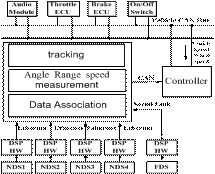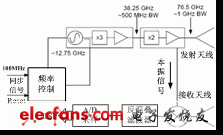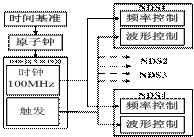1 Introduction
With the continuous improvement of people's requirements for safety and comfort during car driving, car radar is widely used in the adaptive cruise system, anti-collision system and driving support system of the car. Among them, millimeter-wave radar is widely used due to its advantages of high detection accuracy, small hardware size, and freedom from bad weather. However, the traditional single radar sensor still has shortcomings such as small detection range and low reliability. Especially in complex driving conditions, parallel lines, shift lines, turns, ups and downs, and static guardrails, signs, and pedestrians on both sides of the road make it difficult for the radar to identify the main target, and the false alarm rate is high.
This kind of radar sensor integrates a network system that combines the advantages of various sensors, realizes information analysis, synthesis and balance, uses the redundancy and complementary characteristics of data for fault tolerance processing, and overcomes the low reliability of a single sensor , The effective detection range is small and other shortcomings, effectively reducing the false alarm rate of the radar. The new, high-precision sensor network formed in this way can greatly improve the performance of automotive radar network systems [1].
2 The principle of radar network
The radar network shown in Figure 1 is composed of four near-distance millimeter-wave radar sensors (Near Distance Sensors, NDS) distributed equidistantly on the safety bar. Each radar sensor uses the FMCW system. The sensor network can achieve a coverage of 120 ° horizontal azimuth within 35 meters. Such a close-range, large-coverage radar sensor network can monitor targets in a large range forward of the car when the vehicle speed is not high and the road surface condition is relatively complicated (such as city traffic). If long-distance detection is required, a long-range radar sensor can be added in the middle of the safety bar. With the maturity of 77 GHz automotive radar sensor technology, near / long range radar sensors tend to be implemented using 77 GHz MMIC (millimeter wave integrated circuit) technology. Using this technology, it is easy to make an integrated design solution to make the transceiver module The cost is greatly reduced.
In the block diagram of the sensor network system shown in Figure 2 [2], the radar sensor based on 77GHz MMIC technology is the key hardware that constitutes the front end of the automotive radar network. The back-end information processing needs to be completed with high-speed computing units such as digital signal processors. Sensors, digital signal processing units, and data fusion decision systems use Ethernet and high-speed serial connections to transfer data to meet high data rate transmission requirements. The data fusion system adopts a distributed architecture, that is, each proximity sensor performs local processing on the obtained echo signal first, and then sends it to the fusion center for fusion to obtain the target's azimuth and velocity information. The controller is the final decision-making mechanism of the entire radar network system. It is responsible for identifying whether the distance and speed information of the target pose a threat to driving safety, and prompts the driver in the form of sound and light or directly acts on the vehicle control system for adjustment.

Figure 1 The area covered by the automotive radar network

Figure 2 Radar network system structure diagram
2 Key technical solutions for automotive radar networks
Compared with a single radar sensor, the advantages of multi-sensor networking are high measurement accuracy, low false alarm rate, and superior performance of multi-target recognition. The high measurement accuracy and low false alarm rate are due to data fusion technology, which requires each sensor to be accurately synchronized in time and frequency; multi-target recognition depends on the system's ability to recognize and classify targets. Therefore, the design of the entire radar network, including each radar sensor, must be carried out around these two points.
2.1 Design of proximity sensors
The short-range radar sensor is mainly responsible for the detection of targets within 35 meters of the car's forward direction, and is a key part of the automotive radar network's effectiveness in complex road conditions. The short-range radar sensor mainly includes the precise time synchronization control between the radio frequency unit, the receiver and each sensor [2]. In the design of the antenna, it is necessary to meet the requirements of the beam width shown, and at the same time, the volume of the sensor cannot be increased. Therefore, a printed linear array antenna can be used. The receiver is mainly composed of some low-frequency components, anti-aliasing filters and analog-to-digital conversion devices. The noise generated by these low-frequency components can overwhelm the weak echo signal, which is one of the main factors affecting the detection distance, so it is necessary to reduce the noise parameters as much as possible. In addition, the sampling frequency of the analog-to-digital conversion should be determined according to the performance parameters of the proximity sensor [2]. The principle diagram of the proximity sensor is shown in Figure 3.

Figure 3 close-up sensor structure diagram

Figure 4 Block diagram of the synchronization system
2.2 Synchronous control
After the radar is networked, the location of the target is also determined by measuring the frequency difference between the transmitted signal and the echo signal. But unlike single radar detection, the distance and speed of the target measured by the automotive radar network are obtained by data fusion of the target information measured by each sensor. In order to measure the target distance and generate a consistent waveform, the transmitter and receiver must have a unified time standard, which is time synchronization. In order to receive and amplify the echo signal, the transmitter and receiver of the radar sensor must work at the same frequency. When the transmitter frequency is agile, the receiver's local oscillator should be changed accordingly, that is, the frequency should be synchronized. The automotive radar network requires that the time synchronization control error between sensors be within 10 ns. Therefore, a high-precision time-frequency synchronization system is a key technology for automotive radar sensor networking. Figure 4 shows the configuration based on the DDS synchronous clock source [3]. The reference frequency source of the DDS synchronous clock source on each transceiver unit should use highly stable atomic clocks (such as rubidium and cesium atomic clocks). The atomic clock of each transceiver unit should be calibrated regularly with the same time reference. The accuracy of the time reference used for calibration is higher.They can be the time reference signal transmitted by GPS (Navigation Star Global Positioning System), Roland C or color TV transmitter.
Crimping Tool For 8P8C Network and Telephone Cable
Crimping Cutting Tool, RJ45 Crimping Tool, Lan Cable Stripper
Crimping Cutting Tool, RJ45 Crimping Tool, Lan Cable Stripper
Ningbo HanCheng(HC) Electronic Co.,Ltd , https://www.hcwires.com